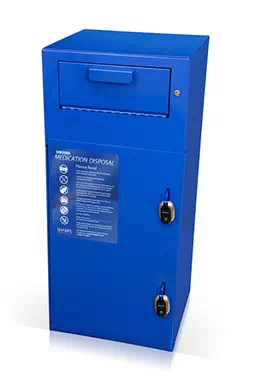 |
||
- Regulated Medical Waste
- Hazardous Materials
- Hazardous Waste
- Pharmaceutical Waste
- Regulations
- Waste Reduction
- Facilities Management
- Assisted Living /
Nursing Homes - Dental Offices
- Search
- Contact
- Home
|
Pharmaceuticals - Controlled Substances
Overview This section summarizes regulations published in the Federal Register September 9, 2014 by the U.S. Drug Enforcement Administration (DEA) regarding the disposal of controlled substances. The final rule was published in accordance with the Controlled Substance Act (CSA), as amended by the Secure and Responsible Drug Disposal Act of 2010 ("Disposal Act"). The rule became effective on October 9, 2014. Among other entities, this rule affects hospitals and long-term care facilities (LTCFs). Controlled substances are drugs that have some potential for abuse or dependence. These drugs are regulated by the DEA to help fight against abuse. The CSA divides controlled substance drugs into five categories called schedules:
Impacts on Hospitals Under the new rule, registered and "authorized" hospitals/clinics with an on-site pharmacy may voluntarily establish a program to accept unwanted controlled substances from ultimate users ("person who has lawfully obtained, and who possesses, a controlled substance for his own use or for the use of a member of his household or for an animal owned by him or by a member of his household."). This is accomplished by maintaining "collection receptacles" at the authorized hospital/clinics. In addition, the rule expands the authority of authorized hospitals/clinics and retail pharmacies to voluntarily maintain collection receptacles at long-term care facilities. This rules does not alter methods by which hospitals dispose of "pharmaceutical wastage" (e.g., drugs dispensed to a patient and not fully used, such as a single dose vial or syringe with remaining controlled substance). Hospitals should continue to use existing policies regarding this wastage (e.g., two witnesses and record of destruction). In addition, no hazardous waste controlled substances can be drain disposed and it is highly recommended that no pharmaceuticals be disposed through the sewer system. To prevent diversion, it is also highly recommended that a sequestration system be used in the nursing unit. There are a variety available on the market using both activated carbon and denaturation processes. Hospital pharmaceutical wastage should not be disposed of in consumer collection receptacles. Also, controlled substances that are collected from ultimate users must not be co-mingled with a registrant's inventory/stock of controlled substances (i.e., registrants may not dispose of controlled substance inventory in a collection receptacle). Unwanted and outdated controlled substances in the pharmacy's inventory must be sent to a reverse distributor for management and destruction or two employees of the pharmacy may witness incineration and complete a Form 41 if an appropriate facility is available. DEA must be notified and permission received prior to registrant destruction. The new rule contains design specifications for collection receptacles and their removable "inner liners" that are intended to prevent misuse and prevent loss of contents. Provisions of the rule also require collection receptacles to be locked or inaccessible to the public when they cannot be monitored by an employee. The installation and removal of the inner liner of the collection receptacle must be performed by or under the supervision of at least two employees of the authorized collector. An authorized collector may collect pharmaceutical controlled substances and non-controlled substances. Controlled and non-controlled pharmaceuticals may be co-mingled in a single collection receptacle, however it is not required. Collected pharmaceutical controlled substances must shipped to a reverse distributor registered with DEA . Form DEA-41 must be used to document the witnessed incineration by the reverse distributor. Impacts on Long-Term Care Facilities An authorized hospital/clinic with an on-site pharmacy or a retail pharmacy may install, manage and maintain a collection receptacle at long-term care facilities (LTCFs). A LTCF may dispose of a current or former resident's pharmaceutical controlled substances into those receptacles. If someone dies while in lawful possession of pharmaceutical controlled substances, any person lawfully entitled to dispose of the decedent's property may dispose of the decedent's pharmaceutical controlled substances. Both pharmaceutical controlled substances and non-controlled substances may be placed in the receptacles. When disposing of pharmaceutical controlled substances by transferring those substances into a collection receptacle, disposal should occur immediately, but no longer than three business days after discontinuation of use by the LTCF resident. Management of the collection receptacles must follow certain prescribed rules:
Upon removal, sealed inner liners may be stored at the LTCF for up to three business days in a securely locked, substantially constructed cabinet or a securely locked room with controlled access. In cases where no hospital/clinic with an on-site pharmacy or retail pharmacy will install or maintain a collection receptacle at a particular LTCF, all currently legal methods of disposal can continue to be used (e.g., mail-back programs or disposal via flushing or otherwise discarding). More Resources Federal Register September 9, 2014. Final rule. A 10-Step Blueprint for Managing Pharmaceutical Waste in US Healthcare Facilities, 2022 version. Pharmacist's Manual. An Informational Outline of the Controlled Substances Act, revised 2022.
|
